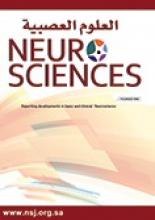Article Figures & Data
Tables
Ability to early identify and manage CES (%) P-valuea Characteristics All participants (N=401) “Proficient ability” (N=52) “Good ability” (N=203) “Fair ability” (N=108) “Poor ability” (N=38) Age, years (mean (SD)) 29.5 (5.5) 29.9 (5.7) 29.6 (5.9) 29.3 (5.2) 29.3 (4.6) 0.945 b Gender (N (%)) 0.243 Male 187 (46.6) 36.5% 46.3% 48.1% 57.9% Female 214 (53.4) 63.5% 53.7% 51.9% 42.1% Highest Academic Education Qualification (N (%)) 0.006 Internship year 7 (1.7) 0.0% 2.5% 1.9% 0.0% Diploma degree 13 (3.2) 3.8% 1.5% 4.6% 7.9% Bachelor’s degree 307 (76.6) 63.5% 75.9% 79.6% 89.5% Master’s degree 64 (16.0) 30.8% 18.2% 9.3% 2.6% PhD degree 10 (2.5) 1.9% 2.0% 4.6% 0.0% Years of practice (N (%)) 0.385 Less than 1 year 88 (21.9) 23.1 25.1 15.7 21.1 From 1 to 5 years 170 (42.4) 42.3 37.9 51.9 39.5 From 6 to 10 years 69 (17.2) 11.5 19.7 15.7 15.8 More than 10 years 74 (18.5) 23.1 17.2 16.7 23.7 Statements Yes n (%) No n (%) Do you use toolkit/guidelines for early identification of cauda equina syndrome? 102 (25.4) 299 (74.6) Agree n (%) Disagree n (%) Full neurological examinations that include sensation when a patient has lower back pain is not important. (Reversed statement) 88 (21.9) 313 (78.1) Cauda equina syndrome does not have a ‘progression pattern’. (Reversed statement) 69 (17.2) 332 (82.8) Suspected cauda equina syndrome stage is when the patient has urinary difficulties of neurogenic origin. 354 (88.3) 47 (11.7) Yes n (%) No n (%) Do you suspect cauda equina syndrome when patients describe their pain by radicular pain of one side or both sides (Ipsilateral radiculopathy or Bilateral radiculopathy)? a 343 (85.5) 58 (14.5) Do you ask your patient when they have bilateral radiculopathy about any bowel/bladder dysfunctions in detail? 226 (56.4) 175 (43.6) Do you give your patient with suspected cauda equina syndrome warning signs card (‘Safety Netting Card’)? 179 (44.6) 222 (55.4) Do you warn and explain to the patient with suspected cauda equina syndrome the red flags symptoms? 289 (72.1) 112 (27.9) Do you document the patient’s signs and symptoms of cauda equina syndrome including duration, frequency and progression and the time and date of every contact immediately? 289 (72.1) 112 (27.9) Agree n (%) Disagree n (%) Communication and simple language are not important with patients with suspected cauda equina syndrome and could not be vital information from patients regarding early cauda equina syndrome symptoms. (Reversed statement) 149 (37.2) 252 (62.8) Correct n (%) Incorrect n (%) What is the appropriate management of patients with suspected cauda equina syndrome? b 146 (36.4) 255 (63.6) Agree n (%) Disagree n (%) The MRI request should state the extreme urgency of investigation and evaluation (or re-evaluation) of the patient with suspected cauda equina syndrome. 353 (88.0) 48 (12.0)






